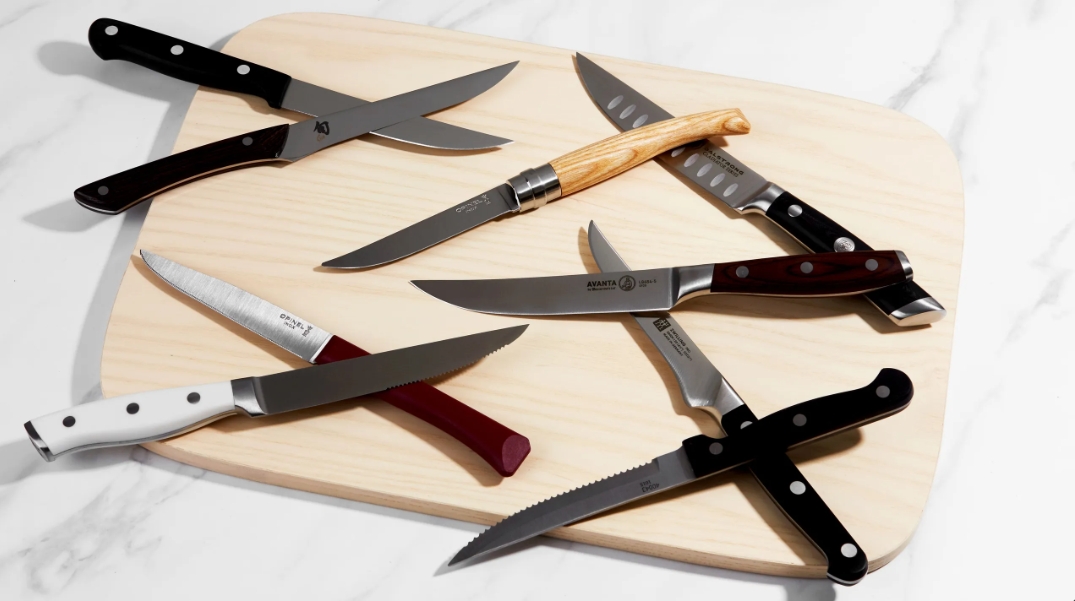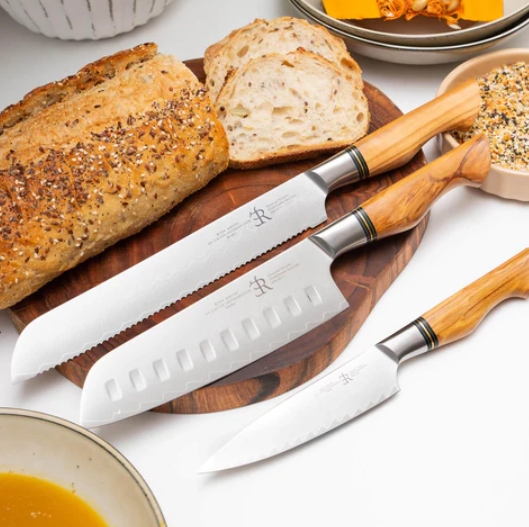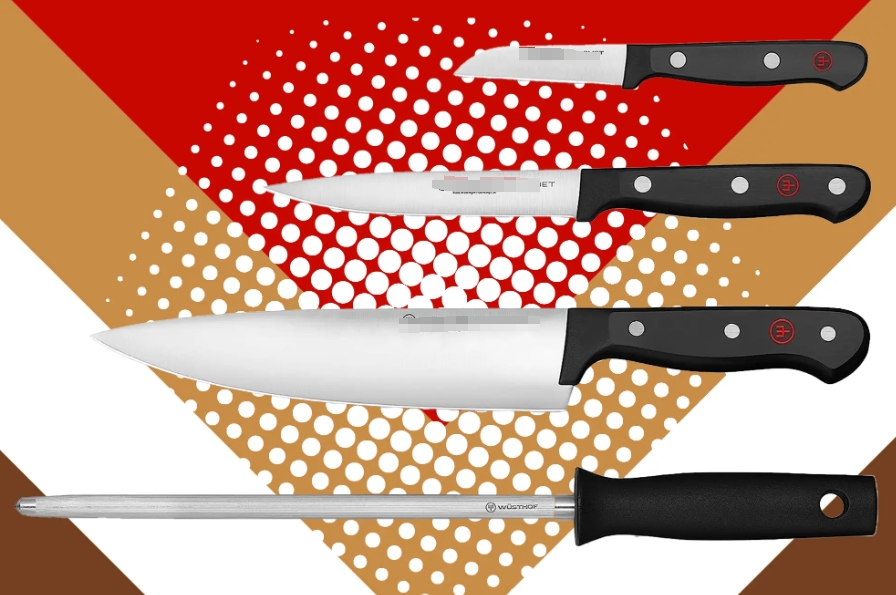

Views: 222 Author: Ella Publish Time: 2025-04-22 Origin: Site








Content Menu
● Understanding the Importance of the Right Kitchen Knife
>> 5. Maintenance Requirements
>> 6. Price
● Western vs. Japanese Knives: Which Should You Choose?
● Handle Materials and Ergonomics
● How to Test a Knife Before Buying
● Knife Maintenance: Keeping Your Knife Sharp and Safe
>> Video
● FAQ: Top 5 Questions About Choosing Kitchen Knives
>> 1. What are the three essential knives every home cook should own?
>> 2. How do I know if a knife is well-balanced?
>> 3. Should I choose a Western or Japanese-style knife?
>> 4. How often should I sharpen my kitchen knife?
>> 5. What's the best way to care for my kitchen knife?
Selecting the perfect kitchen knife is a foundational step for anyone who enjoys cooking, whether you're a beginner or a seasoned home chef. The right knife not only makes food preparation easier and more efficient but also ensures safety and elevates your culinary results. This comprehensive guide will walk you through everything you need to know to choose the best kitchen knife for everyday use, including types, materials, ergonomics, maintenance, and more. We'll include plenty of illustrative images and videos to help you visualize each concept.

A kitchen knife is arguably the most important tool in your culinary arsenal. Whether you're dicing onions, slicing bread, or filleting fish, the right knife can make your tasks faster, safer, and more enjoyable. A sharp, well-balanced knife reduces the risk of accidents and helps you achieve precise cuts, which is crucial for both presentation and even cooking[2][20].
Here's a breakdown of the most common kitchen knives and their primary functions:
| Knife Type | Blade Length | Primary Uses |
|---|---|---|
| Chef's Knife | 6–10 inches | Chopping, dicing, mincing, slicing |
| Bread Knife | 8–12 inches | Slicing bread, cakes, tomatoes |
| Paring Knife | 3–4 inches | Peeling, coring, trimming, small precision tasks |
| Utility Knife | 4–7 inches | Slicing fruits, vegetables, cheeses |
| Santoku Knife | 5–7 inches | Slicing, chopping, mincing (Japanese style) |
| Nakiri Knife | 6–8 inches | Chopping vegetables (Japanese style) |
| Boning Knife | 5–7 inches | Removing bones from meat and fish |
| Cleaver | 7–8 inches | Cutting through bones, tough vegetables |
Chef's Knife: The most versatile and essential knife. Handles about 80% of cutting tasks in the kitchen[3][8][20].
Bread Knife: Serrated edge for cleanly slicing bread and soft produce like tomatoes[3][8][11].
Paring Knife: Small, nimble blade for precision tasks like peeling and coring[3][8][11].
Utility Knife: Great for slicing smaller fruits, vegetables, and cheeses[3][8][11].
Santoku/Nakiri: Japanese knives ideal for vegetables and fine slicing[3][8][11].
Selecting the right knife involves more than just picking the sharpest blade. Here are the most important factors:
A good knife should feel like an extension of your hand. It must be comfortable to grip, well-balanced, and suited to your hand size and cutting style[1][10][20].
The steel's quality determines sharpness, edge retention, and ease of maintenance. Common options include stainless steel, high-carbon steel, and ceramic[1][14][15].
Choose a blade shape that matches your most common kitchen tasks. An 8-inch chef's knife is the sweet spot for most home cooks[2][8][14].
Some cooks prefer heavier knives for chopping, while others like lighter knives for agility. The knife should feel balanced, with the weight evenly distributed between blade and handle[10][14][20].
Consider how often you're willing to sharpen your knife and whether you want to learn to do it yourself[1][12][19].
Quality knives range from affordable to premium. Invest in the best you can reasonably afford, as a good knife lasts many years[1][2][15].
| Feature | Western (German/French) | Japanese (Gyuto, Santoku, etc.) |
|---|---|---|
| Steel Hardness | Softer (55–60 HRC) | Harder (60+ HRC) |
| Blade Shape | More curved for rocking cuts | Straighter edge for push/pull chopping |
| Weight | Heavier, thicker | Lighter, thinner |
| Edge Retention | Needs more frequent sharpening | Holds edge longer, but can chip |
| Best For | Dense foods, meat, root vegetables | Precision slicing, vegetables, fish |
Western knives are robust and forgiving, ideal for heavy-duty tasks. Japanese knives are sharper and lighter, excelling at precision and delicate work[8][13][15].
| Material | Pros | Cons |
|---|---|---|
| Stainless Steel | Rust-resistant, easy to maintain | Loses edge faster |
| High-Carbon Steel | Holds edge well, easy to sharpen | Prone to rust and staining |
| High-Carbon Stainless | Combines benefits of both | More expensive |
| Ceramic | Extremely sharp, lightweight | Brittle, can chip or break easily |
Full-tang knives (where the blade runs through the handle) are generally more durable and balanced[14][15].

Handles come in wood, plastic, and composite materials. Each has its own feel, maintenance needs, and aesthetics:
- Wood: Comfortable, classic look, but needs more care.
- Plastic: Durable, easy to clean, but can feel less premium.
- Composite: Combines durability and grip with attractive looks[10][15].
Choose a handle that feels secure and comfortable in your hand, especially during longer prep sessions[1][20].
Before purchasing, if possible, hold the knife to check its weight, balance, and grip. It should feel comfortable and natural, with no heavy or light spots that throw off your cutting motion[10][20].
- Test the rocking motion: Try a chopping motion on a cutting board.
- Check the grip: Ensure your fingers don't slip and the handle doesn't dig into your palm.
- Balance: The knife should not tip forward or backward when held at the bolster (where blade meets handle).
A good knife is an investment—proper maintenance ensures it lasts for years:
- Hand wash and dry immediately after use. Never use a dishwasher, which can dull and damage the blade[12][19].
- Sharpen regularly using a whetstone, honing rod, or professional service[12][19].
- Store safely in a knife block, on a magnetic strip, or in a sheath to protect the edge[19].
- Cut on wooden or plastic boards. Avoid glass or stone, which can dull the blade[19].
Chef's knife cutting vegetables
How to Use a Chef's Knife
Basic Knife Skills | Allrecipes
Use a Knife Like a Chef
Choosing the right kitchen knife for everyday use is about understanding your cooking habits, hand size, and comfort preferences. For most home cooks, an 8-inch chef's knife is the most versatile and essential tool, capable of handling the majority of kitchen tasks. Complement it with a bread knife and a paring knife for a well-rounded setup. Pay attention to the blade and handle materials, weight, balance, and maintenance requirements to ensure your knife serves you well for years. Remember, a sharp, comfortable knife not only makes cooking easier and more enjoyable but also safer.

Most experts recommend starting with a chef's knife, a bread knife, and a paring knife. These three cover about 95% of everyday kitchen tasks, from chopping vegetables to slicing bread and peeling fruit[3][8][11].
A well-balanced knife will feel comfortable and stable in your hand, with the weight evenly distributed between the blade and handle. Hold the knife at the bolster; it shouldn't tip forward or backward[10][20].
Choose a Western-style knife if you prefer a heavier, more robust blade for tough ingredients. Opt for a Japanese-style knife if you value sharpness, precision, and lighter weight, especially for vegetables and fish[8][13][15].
Sharpen your knife whenever you notice it's not cutting as easily. For most home cooks, this means every few months. Regular honing with a rod between sharpenings helps maintain the edge[12][19].
- Hand wash and dry immediately after use.
- Store safely in a block, sheath, or on a magnetic strip.
- Sharpen and hone regularly.
- Use only on wood or plastic cutting boards.
- Avoid cutting bones, frozen foods, or hard surfaces[12][19].
[1] https://sharpedgeshop.com/blogs/knives-101/how-to-choose-a-kitchen-knife
[2] https://www.nytimes.com/wirecutter/reviews/the-best-chefs-knife-for-most-cooks/
[3] https://madeincookware.com/blogs/types-of-kitchen-knives
[4] https://www.knivesandtools.com/en/ct/buying-guide-knife-sets.htm
[5] https://www.istockphoto.com/photos/kitchen-knife
[6] https://www.youtube.com/watch?v=-al-bs737fw
[7] https://www.youtube.com/watch?v=FNuV7lg6jgg
[8] https://prudentreviews.com/types-of-kitchen-knives/
[9] https://www.youtube.com/watch?v=Ydc_SaQ_eRQ
[10] https://elementknife.com/pages/common-questions-about-kitchen-knives
[11] https://www.ikea.com/us/en/rooms/kitchen/how-to/knife-guide-choose-the-right-knife-for-your-kitchen-tasks-pub3cb4555b/
[12] https://northernknife.com/blogs/blogs/the-essential-guide-to-maintaining-your-knife
[13] https://www.divertimenti.co.uk/blogs/the-cookery-edit/common-knife-questions
[14] https://theintrepidgourmet.com/2023/04/03/how-to-choose-a-chef-knife/
[15] https://www.goodhousekeeping.com/cooking-tools/best-kitchen-knives/g646/best-kitchen-cutlery/
[16] https://stahlkitchens.com/blogs/news/types-of-knives
[17] https://www.istockphoto.com/illustrations/chef-knife
[18] https://www.youtube.com/watch?v=os8xnwxcHg0
[19] https://artisanrevere.com/blogs/education/knife-faq-and-problem-solving
[20] https://morakniv.se/en/guides/knife-guide-right-kitchen-knives/
[21] https://www.benchmade.com/collections/cutlery
[22] https://sharpedgeshop.com/blogs/knives-101/guide-maintenance-of-kitchen-knives
[23] https://knife-depot.com/pages/the-complete-guide-to-buying-kitchen-knives
[24] https://www.seriouseats.com/the-best-essential-knives
[25] https://www.kitchenkapers.com/pages/how-to-choose-kitchen-knives
[26] https://www.reddit.com/r/cookingforbeginners/comments/f7shfw/factors_to_look_our_for_when_finding_a_good_knife/
[27] https://www.reddit.com/r/cookingforbeginners/comments/1781thp/knife_buying_guide/
[28] https://www.youtube.com/watch?v=GjHaMLsHUUQ
[29] https://www.reddit.com/r/chefknives/comments/17vrh98/a_good_set_of_knives_for_the_home_kitchen_for_an/
[30] https://kamikoto.com/blogs/fundamentals/understanding-kitchen-knives-types
[31] https://www.consumerreports.org/home-garden/kitchen-knives/buying-guide/
[32] https://nymag.com/strategist/article/best-kitchen-knife-sets.html
[33] https://www.everythingkitchens.com/knife-education-guide.html
[34] https://www.williamhenry.com/wh-insider/main-qualities-of-kitchen-knives/
[35] https://stock.adobe.com/search?k=chef+knife
[36] https://unsplash.com/s/photos/chef-knife
[37] https://www.vecteezy.com/free-vector/kitchen-knife
[38] https://www.youtube.com/watch?v=sNoVeQw8Ie0
[39] https://madeincookware.com/blogs/types-of-kitchen-knives
[40] https://www.youtube.com/watch?v=G-Fg7l7G1zw
[41] https://www.wusthof.com/collections/all-purpose-knives/chefs-knives
[42] https://www.youtube.com/watch?v=YrHpeEwk_-U
[43] https://www.youtube.com/watch?v=Z8Rw3-mVgrQ
[44] https://www.reddit.com/r/chefknives/comments/ngdsyy/the_video_that_helped_explain_the_basics_of_chef/
[45] https://cutco.com/shop/kitchen-knives
[46] https://theveroknives.com/blogs/faq-guides/the-ultimate-kitchen-knife-guide-expert-faqs-maintenance-tips-and-buying-advice
[47] https://www.kitchenknifeforums.com/threads/questions-to-ask-when-buying-a-knife.47508/
[48] https://artisanrevere.com/blogs/all/ultimate-guide-to-knife-care
[49] https://www.reddit.com/r/chefknives/comments/9586ql/what_to_look_for_in_a_chef_knife/
[50] https://www.cookingmanager.com/questions-buying-kitchen-knives/
[51] https://misen.com/pages/knives-care
[52] https://www.bladeforums.com/threads/question-for-the-kitchen-knife-folks-and-chefs.1298526/
[53] https://www.tigerchef.com/complete-guide-to-kitchen-knives.html